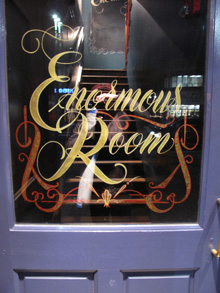Coming to AmericaAfter weighing the difficult decision to leave his family and a girlfriend behind, in 2004 Nakayama arrived at Logan Airport with little in the way of savings. He didn't expect to see his own name in big letters; instead he hoped to paint the names of others, and perhaps one day lend his own flavor to America's street-and-alley aesthetic. Unlike many Butera students, who Nakayama's mentor Birmingham says often lose interest in the intensive two-year program, the Japanese prodigy proved exceptional.
"He was full of piss and vinegar from day one," says Birmingham. "In 16 years of teaching there, and going there before that, there have only been maybe three or four like Kenji. It was unbelievable what he gave up to come here — almost as incredible as what he's done since."
While at Butera, Nakayama began producing pieces outside of class — mostly layered stencils that re-imagined still photos that he'd taken in the shadows of the grimey underside of Boston. Birmingham pushed him to keep at it, and before long the burgeoning artist was showing at Starbucks on Newbury Street, then at a number of shops and bars around town. There was a lot of rejection — "Many people told me 'No,' " he says — still he grew determined to become a full-fledged artist.
At the same time, Nakayama was incorporating his sign hustle with new ideas, and landing adventurous commissioned work like the job he did with contemporary street artist Ryan Lombardi at the recently closed Enormous Room, where the pair decked the stairs, DJ booth, and window in 23-karat gold-leaf swag. "Kenji is probably the most passionate and creative artist who I've had the opportunity to work with," says Lombardi, a force in his own right. Adds Lot F owner James Wormser: "All of the other artists look up to him. As long as I've been around, Kenji's been a legend in Boston."

TOOLS OF THE TRADE The front door of the Enormous Room bears the personalized lettering and calligraphic pin-striping that are hallmarks of Nakayama’s art. |
Work ethicAnecdotal evidence points to a sign-painting resurgence. Filmmakers Faythe Levine and Sam Macon spent the past two years surveying the nascent scene across the country, interviewing active sign painters, designers, and knowledgeable curators who are directly attached to the history and current movement. Dropping later this year along with a book of the same name, their film Sign Painters will look behind the signs that brighten bohemian enclaves like Boston and the Bay Area.
"There seems to be a resurgence across the board," says Macon, who also collaborated on the 2009 DIY doc Handmade Nation with Levine. Macon says the trade — not to mention its more stylized variants — has come far since the '90s, when teachers at LA Tech were scouting probation offices and Venice Beach graffiti hangouts for recruits. "From the beginning of our project we've been amazed at how much more there is than what we thought, by the variety of people who are doing it, and by how the new generation is approaching sign making."